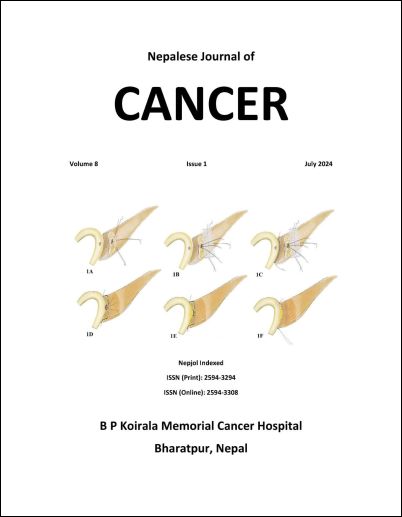Indocyanine Green (ICG) fluorescence angiography of gastric conduit for reconstruction after esophagectomy: a single center prospective study
DOI:
https://doi.org/10.3126/njc.v8i1.68237Keywords:
Esophagectomy,, gastric conduit reconstruction, indocyanine green fluorescence angiography, anastomotic leakAbstract
Introduction: Esophageal cancer ranks among the most aggressive neoplasms worldwide and is a significant contributor to cancer-related mortality. Surgical intervention through esophagectomy with radical lymph node dissection remains a cornerstone in the curative treatment of mid and lower esophageal and gastroesophageal junction tumors, often preceded by neoadjuvant therapy tailored to histological type. Anastomotic leak (AL) following gastroesophageal anastomosis is a major complication associated with substantial morbidity and mortality.
Methods: A prospective study was conducted on 30 patients undergoing esophagectomy with gastric conduit reconstruction from May 2023 to April 2024. Gastroesophageal anastomosis was placed at neck. Intraoperatively, indocyanine green (ICG) fluorescence angiography was employed to assess gastric conduit perfusion. The anastomosis site was selected based on ICG fluorescence dynamics, aiming for anastomosis within 45 seconds of ICG enhancement.
Results: The study cohort comprised predominantly male patients (60%) with a mean age of 60.67 years. Most patients presented with squamous cell carcinoma (66.67%), primarily located in the lower esophagus and minimally invasive surgery was predominantly performed. Mean ICG fluorescence angiography time was 32.1 seconds. Anastomotic leak occurred in 23.3% of patients, correlating with significantly longer hospital stays (p=0.005). Although ICG fluorescence angiography was used to guide anastomosis based on perfusion assessment, there was no statistically significant reduction in AL rates observed in this study (p=0.471).
Conclusion: In conclusion, while ICG fluorescence angiography represents an innovative approach to evaluating gastric conduit perfusion during esophagectomy, its direct impact on reducing AL in our study was not statistically significant.
Downloads
Downloads
Published
How to Cite
Issue
Section
License
Copyright (c) 2024 Nepalese Journal of Cancer

This work is licensed under a Creative Commons Attribution 4.0 International License.
This license lets others distribute, remix, tweak, and build upon your work, even commercially, as long as NJC and the authors are acknowledged.
Submission of the manuscript means that the authors agree to assign exclusive copyright to NJC. The aim of NJC is to increase the visibility and ease of use of open access scientific and scholarly articles thereby promoting their increased usage and impact.




